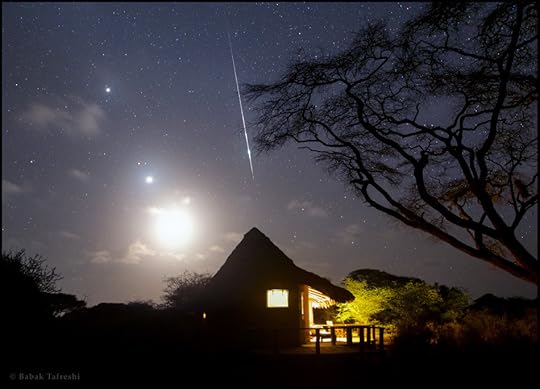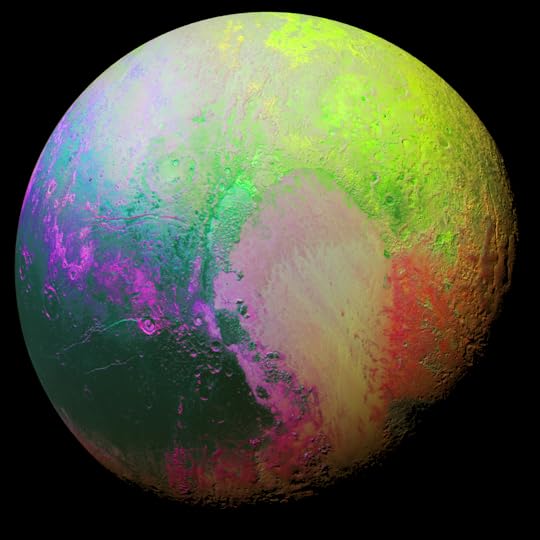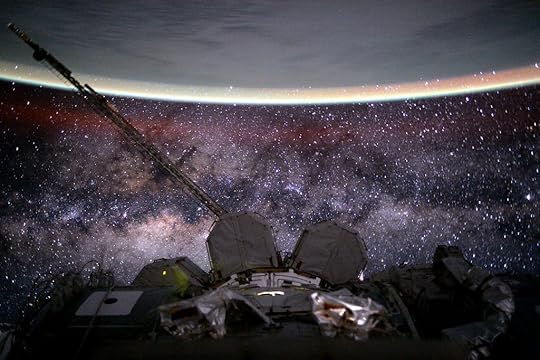P.P. Corcoran's Blog, page 3
November 12, 2015
Kenya Morning Moon, Planets and Taurid

On November 8, a waning crescent Moon joined the continuing parade of planets in Earth’s early morning skies. Captured here from Amboseli National Park, Kenya, even the overexposed moonlight can’t washout brilliant Venus though, lined up near the ecliptic plane with faint Mars and bright Jupiter above. As if Moon and planets aren’t enough, a comparably bright Taurid meteor also streaks through the scene. In fact November’s Taurid meteor showers have had a high proportion of bright fireballs. Apparently streaming from radiants in Taurus, the meteors are caused by our fair planet’s annual passage through debris from Comet 2P/Encke. The comet’s dust grains are catching up with Earth’s atmosphere at a relatively low speed of about 27 kilometers per second. via NASA http://ift.tt/1O5pLr7


Published on November 12, 2015 21:50
Psychedelic Pluto

New Horizons scientists made this false color image of Pluto using a technique called principal component analysis to highlight the many subtle color differences between Pluto’s distinct regions. via NASA http://ift.tt/1llORbL


Published on November 12, 2015 09:20
November 11, 2015
An Unexpected Rocket Plume over San Francisco

What is that unusual light in the sky? A common question, this particular light was not only bright but moving and expanding. It appeared just as the astrophotographer and his friend were photographing the Golden Gate Bridge in San Francisco, California against a more predictable night sky. They were not alone in seeing this unusual display — at least hundreds of people in California reported a similar sight. The consensus of experienced sky observers was that the plume resulted from a rocket launch — an explanation that was soon confirmed as an unpublicized test of a submarine-launched, unarmed, Trident II D5 nuclear missile. Such tests are not uncommon but do not usually occur just after sunset near a major metropolitan area — when they are particularly noticeable to many people. Were plume images not posted to the Internet and quickly identified, such a sky spectacle might have been understood by some to be associated with more grandiose — but incorrect — explanations. via NASA http://ift.tt/1M6mZ46


Published on November 11, 2015 21:41
November 10, 2015
AE Aurigae and the Flaming Star Nebula

Is star AE Aurigae on fire? No. Even though AE Aurigae is named the flaming star, the surrounding nebula IC 405 is named the Flaming Star Nebula, and the region appears to have the color of fire, there is no fire. Fire, typically defined as the rapid molecular acquisition of oxygen, happens only when sufficient oxygen is present and is not important in such high-energy, low-oxygen environments such as stars. The material that appears as smoke is mostly interstellar hydrogen, but does contain smoke-like dark filaments of carbon-rich dust grains. The bright star AE Aurigae, visible toward the right near the nebula’s center, is so hot it is blue, emitting light so energetic it knocks electrons away from surrounding gas. When a proton recaptures an electron, light is emitted, as seen in the surrounding emission nebula. Pictured above, the Flaming Star nebula lies about 1,500 light years distant, spans about 5 light years, and is visible with a small telescope toward the constellation of the Charioteer (Auriga). via NASA http://ift.tt/20JM3Wc


Published on November 10, 2015 21:43
Scott Kelly on the Second Spacewalk of Expedition 45

On Nov. 6, 2015, NASA astronauts Scott Kelly and Kjell Lindgren spent 7 hours and 48 minutes working outside the International Space Station on the 190th spacewalk in support of station assembly and maintenance. The astronauts restored the port truss (P6) ammonia cooling system to its original configuration, the main task for the spacewalk. via NASA http://ift.tt/1kK3Z2c


Published on November 10, 2015 08:47
November 9, 2015
Layers and Fractures in Ophir Chasma, Mars

Ophir Chasma forms the northern portion of the vast Mars canyon system Valles Marineris, and this image, acquired on Aug. 10, 2015, by the High Resolution Imaging Science Experiment (HiRISE) camera on NASA’s Mars Reconnaissance Orbiter, features a small part of its wall and floor. via NASA http://ift.tt/1RIGilw


Published on November 09, 2015 09:53
November 8, 2015
A Quadruple Sky Over Great Salt Lake

This was a sky to show the kids. All in all, three children, three planets, the Moon, a star, an airplane and a mom were all captured in one image near Great Salt Lake in Utah, USA in early September of 2005. Minus the airplane and the quadruple on the ground, this busy quadruple coincidence sky was visible last week all over the world. The easiest object to spot is the crescent Moon, which is easily the brightest sky orb in the featured image. Venus is the highest planet in the sky, with Jupiter to its right. The bright star Spica completes the quadruple just below Venus. The streak on the far right is an airplane. Mom is seated. Grandpa, appreciating the beauty of the moment, took the picture. This week, the pre-dawn sky shows a similar conjunction of planets. via NASA http://ift.tt/1MF1DYF


Published on November 08, 2015 21:25
November 7, 2015
Earth and Milky Way from Space

Since November 2000, people have been living continuously on the International Space Station. To celebrate humanity’s 15th anniversary off planet Earth, consider this snapshot from space of our galaxy and our home world posing together beyond the orbital outpost. The Milky Way stretches below the curve of Earth’s limb in the scene that also records a faint red, extended airglow. The galaxy’s central bulge appears with starfields cut by dark rifts of obscuring interstellar dust. The picture was taken by Astronaut Scott Kelly on August 9, 2015, the 135th day of his one-year mission in space. via NASA http://ift.tt/1WHqpNE


Published on November 07, 2015 21:27
November 6, 2015
Unraveling NGC 3169

Spiral galaxy NGC 3169 appears to be unraveling in this cosmic scene, played out some 70 million light-years away just below bright star Regulus toward the faint constellation Sextans. Its beautiful spiral arms are distorted into sweeping tidal tails as NGC 3169 (top) and neighboring NGC 3166 interact gravitationally, a common fate even for bright galaxies in the local universe. In fact, drawn out stellar arcs and plumes, indications of gravitational interactions, seem rampant in the deep and colorful galaxy group photo. The picture spans 20 arc minutes, or about 400,000 light-years at the group’s estimated distance, and includes smaller, dimmer NGC 3165 at bottom right. NGC 3169 is also known to shine across the spectrum from radio to X-rays, harboring an active galactic nucleus that is likely the site of a supermassive black hole. via NASA http://ift.tt/1HwIozs


Published on November 06, 2015 21:23
Orion Service Module Stacking Assembly Secured For Flight

The Orion spacecraft service module stacking assembly interface ring and stack holding stand are secured on a special transportation platform and are being loaded into NASA’s Super Guppy aircraft at the Shuttle Landing Facility at Kennedy Space Center. On Nov. 3, the Guppy flew from Kennedy to Glenn Research Center’s Plum Brook Station facility. via NASA http://ift.tt/1GOPEMa


Published on November 06, 2015 08:29



